 |
 |
 |
| |
Inflammation, Cancers and Other Life Threats for People Living with HIV
|
| |
| |
NATAP at CROI 2009
David Alain Wohl, MD - The University of North Carolina
Lost on the young but obvious to the old, is the fact we are not immortal. Those with chronic illnesses such as HIV infection are often all too well aware of the Damocles sword under which they live their lives. Fortunately, over the past decade or so mortality rates among HIV-positive persons in resource-rich nations have dropped. But, they remain in excess of those without the virus.
So, what do HIV-infected people die from in the era of potent antiretrovirals? What accounts for seemingly higher rates of disease associated with aging among those who are HIV-positive? Are "non-AIDS-related" conditions such as cardiovascular diseases and common malignancies actually a consequence of viral replication and/or relative immuno-suppression? These weighty questions were tackled by a number of presentations at this year's Conference on Retroviruses and Opportunistic Infections (CROI) and the data suggest that HAART may be an incredible savior but does not erase all the risks associated with HIV infection.
D:A:D and Death
A clear, albeit macabre, picture of HIV-mortality in the time of HAART emerges with the help of data from a number of reports at this CROI. Foremost, the D:A:D prospective cohort study of over 33,000 patients examined deaths among study participants using relatively rigorous procedures for detection and ascertainment of mortality. In this study, there were 2,192 deaths over 158,959 person-years - a death rate of 13.8 per 1000 person-years (95% CI 13.2-14.4) (1). The lion's share of mortality was due to four major conditions: AIDS, liver disease, cardiovascular disease (CVD)- and non-AIDS cancer. Importantly, most deaths were at the hands of conditions not considered to be directly AIDS-related - a finding echoed in all other reports of mortality among those with HIV-infection.
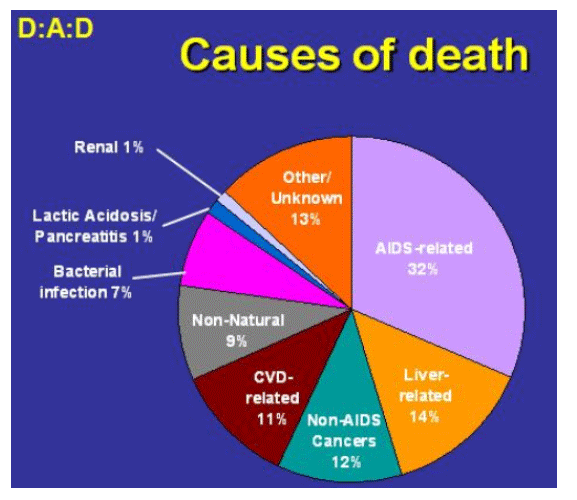
For each of the four major attributed causes of death, the investigators examined the impact of modifiable risk factors for death, broken into the HIV-related (CD4 and HIV RNA levels) and the non-HIV related (smoking, body mass index, diabetes, viral hepatitis co-infections and hypertension), as well as the non-modifiable risks of age and gender.
Each risk factor was found to have somewhat differing associations with fatal CVD, liver disease, non-AIDS cancer and AIDS-related conditions. Growing old is not good for your health and here we see that time not only increases the odds of death but also death at the hands of each of these four major categories of disease. In contrast, males were at a slightly greater risk of dying from any cause but not from any of these particular causes. Smokers beware as current and even former smoking was associated with higher risk of death overall and from CVD and non-AIDS malignancies. It will come as no surprise that hypertension and diabetes increased the risk for CVD and viral hepatitis was associated with liver disease among other causes of death. HIV-related modifiable risk factors of CD4 and viral load also had obvious associations with mortality, including non-AIDS fatal conditions.
An analysis of fatal and serious non-fatal events among those included in the EuroSIDA database of HIV infected persons in Europe (which may well include participants in the D:A:D cohort) also found high rates of life-threatening conditions not directly linked to AIDS (2). The EuroSIDA presentation nicely shows the exact types of conditions people living with HIV develop both the AIDS-defining illnesses (ADIs) and the non-AIDS-defining illnesses (Non-ADIs).
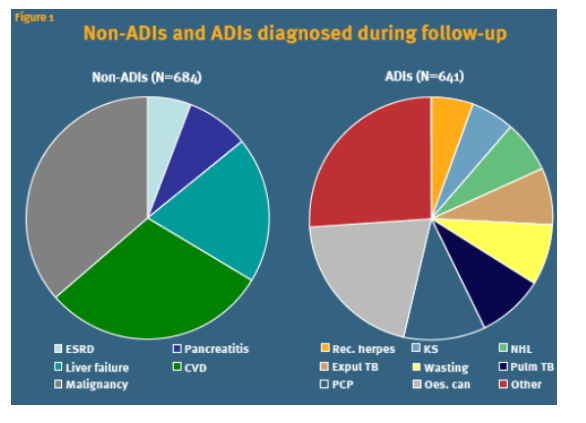
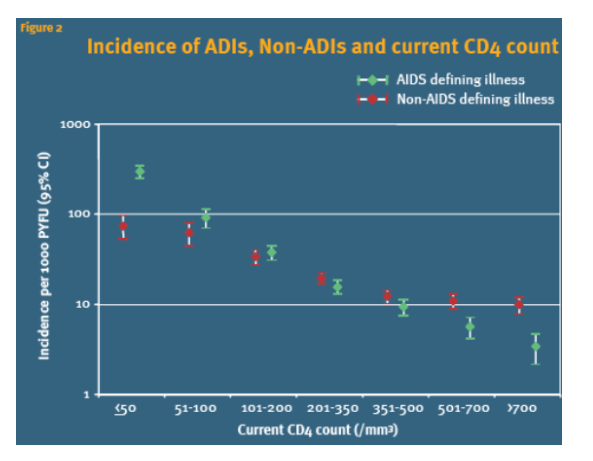
Both the D:A:D and the EuroSIDA studies found serious AIDS-associated conditions as well as more traditional life-threatening illnesses were more likely as the CD4 cell count dropped. Why non-AIDS-related conditions increase with immuno-suppression is not well explained. As detailed below, there are emerging data supporting a role for an accelerated aging effect of HIV infection that may produce myriad effects from accelerated immuno-senescence to advancing CVD.
Indeed, data presented from the Kaiser Permanente group in Southern California indicate that hospitalization for myocardial infarction (MI) and stroke were uncommon among HIV-infected members (3.0 and 1.8 per 1,000 person-years, respectively) (3). However, these rates were nearly double those of members not HIV-infected. Whether this excess CVD was a consequence of an HIV-mediated effect or HIV-infected persons having more risk factors for atherosclerosis (i.e. smoking) remains unclear in this and other studies and gets to the heart of the difficulty of assessing how much is too much when it comes to diseases of aging and HIV. For example, a report from the FRAM cohort, which includes HIV-infected (n=922) and -uninfected (n=278) participants found that those with HIV had a 12% mortality rate compared to 2% among the controls (4 #706). Mortality risk remained three-fold higher for those with HIV infection even after controlling for demographic and traditional CVD risk factors. Importantly, even those with CD4 cell counts above 350/mm3 had higher mortality rates than the uninfected controls.
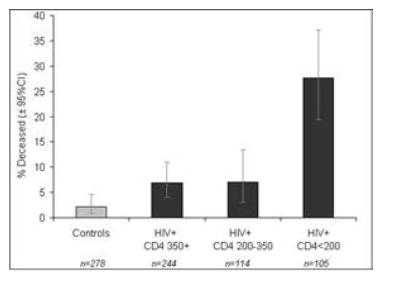
What This Means: There are no stunning revelations in the mortality analysis from D:A:D or the results from EuroSIDA and the conclusion that we should advise our patients to stop smoking, control their blood pressure and sugar, treat their co-infections and while we are at it make certain their CD4 cell counts are high and viral loads low, borders on the hackneyed and self-evident. Yet, the value of the studies lie mostly in their quantifying the risks for death from conditions that are responsible for excess mortality among HIV-infected persons and can often be prevented.
The increasing rate of death due to conditions not traditionally attributed to AIDS seen in the D:A:D and EuroSIDA studies makes sense. If people are not succumbing to AIDS they will eventually get other diseases, such as the CVD and cancers that cut our all too thin tether to this mortal world.
So, on the one hand, way too many people continue to die from diseases that are well-associated with HIV infection. Though not spelled out by the studies presented at CROI, those developing AIDS-related events had more advanced HIV disease and clinical experience would predict these including those presenting late for care, those with sub-optimal treatment adherence and patients who are veterans of the therapeutic incrementalism that led us from monotherapy with zidovudine to the current quadruple drug combinations.
On the other hand, non-AIDS-defining but possibly HIV-influenced conditions such as malignancies and CVD are becoming more common among HIV-infected persons. Mortality rates overall among HIV-infected persons, of course, are much lower now than they were pre-HAART. Therefore, CVD and cancer are not taking the place of opportunistic conditions. However, an undercurrent at this CROI was a concern about how many people in the current treatment era are dying - perhaps prematurely. The NA-ACCORD study of when to start HIV therapy - arguably one of the most significant presentations at this conference - reported 606 deaths among 9,155 patients (28,032 person-years of follow-up) starting with CD4 cell counts above 500/mm3 and observed for no more than 1.5 years between 1996 and 2006 (5). Even among the 2,600 patients treated with antiretrovirals at counts above 500/mm3, almost 200 had died. That seems like a lot and may be a consequence of this study being conducted in North America, where an urban lifestyle and HIV infection can conspire to make life nasty, brutish and short. Maybe. What these souls died from we do not yet know but one suspects that with such high CD4 cell counts it wasn't PCP.
Once connected, the data dots from these studies reveal an image of increased risk of diseases associated with aging among HIV-infected persons in the current era of HAART. A complex interplay of HIV, antiretrovirals, genetics and lifestyle may be at work behind this enhanced risk of conditions linked to human obsolescence. As discussed below, a potential common pathogenic pathway for HIV-associated accelerated aging is materializing.
A Unified Theory of Badness: Inflammation
Stroll through the poster pavilion at CROI this year and you could not be blamed for coming away with a sense that the HIV research community had finally found the evil at the root of the bad things that happen to good people on good drugs. This anti-ambrosia? Inflammation. Chronic inflammation and its collateral damage to endothelial function we learned may explain why some people develop HIV-associated cognitive deficits, account for the adverse events that quickly follow antiretroviral interruption, provide a plausible mechanism for abacavir's role in myocardial infarction (if it has one), predict who will develop a life-threatening opportunistic condition and who gets a life-threatening immune reconstitution syndrome.
The putative role of inflammation in the story of our demise is not new but over the past year we have seen considerable attention paid to pro-inflammatory proteins and their association with the fortunes of HIV-infected people. Ushering in this new found inflammation appreciation was the analysis of inflammatory and coagulation markers from the landmark SMART trial comparing antiretroviral treatment interruption/deferral to continuous HIV therapy (6). The excess AIDS-related and non-AIDS related events suffered by those randomized to interrupt/delay therapy is neatly explained by the high levels of markers of inflammation (IL-6, hsCRP) and coagulation (D-dimer) seen in these patients relative to those who continued their antiretrovirals. At CROI there were studies that explicitly implicated inflammation and coagulation cascades in disease, and others where the influence of these processes, although not demonstrated were implied.
An association between HIV infection and excess inflammation was reported by members of the INSIGHT study group who examined and compared the levels of inflammatory and coagulation biomarkers among the SMART study participants as well as subjects of two large CVD cohorts of persons not known to be HIV-infected: the CARDIA Study and the MESA Study (7). Most of the SMART study subjects were taking HAART and of these, two thirds had a viral load below 400 copies/mL. IL-6, hsCRP and D-dimer levels were 50% to 100% higher among the SMART study subjects than the HIV-uninfected CARDIA and MESA study participants of similar age. These differences persisted even after adjustment for CVD risk factors and seemed to be greater among those who were older (i.e. >45 years of age) than those who were younger. Within the SMART cohort the inflammatory markers were not different among those receiving and not receiving antiretrovirals. However, D-dimer levels, a marker associated with mortality in this cohort, were greater among those not on HIV therapy. These results are a smoking gun implicating inflammation and its downstream sequelae in the excess morbidity and mortality of HIV-infected persons, even those receiving HIV treatment.
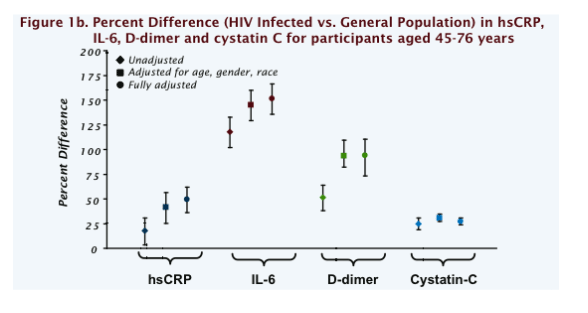
Another examination of the SMART study participants looked to see whether elevated inflammatory markers among HIV-infected persons was linked to development of an opportunistic disease (8). In this study of 5,472 individuals, 91 developed an opportunistic condition (79% infective; 13% malignant). These participants and two matched controls from the cohort had stored blood from baseline and the visit prior to the opportunistic disease event analyzed for hsCRP, IL-6, amyloid A, amyloid P, D-dimer and prothrombin fragment 1+2. As has been previously reported, those randomized in this trial to stop or defer antiretroviral therapy had increased risk of an opportunistic disease event (OR 3.8 95%CI 2.1 to 6.9); other factors associated with these events included a history prior opportunistic disease and older age. Subjects who at baseline (before HIV therapy was interrupted) had higher levels of IL-6 or hsCRP had significantly greater risk for opportunistic conditions than those with lowest levels. When looking at biomarker levels during the study, the risk of an opportunistic event was also greater among those with high levels of IL-6 or hsCRP. Importantly, there was no interaction between treatment arm and baseline and on-study biomarker levels and development of an opportunistic disease. Therefore, these markers seem to be a harbinger of risk not only of CVD and other non-AIDS-related conditions but also AIDS-associated diseases.
A more implicit role for inflammation could be read into work linking the metabolic syndrome to cognitive impairment. For instance, an analysis conducted using data collected from 145 HIV-infected patients found that waist circumference (bigger was worse), diabetes, and AIDS were all significantly associated with neurocognitive impairment (9). The cause for this cognitive effect is unclear but, the presenters hint, could lie in increases in inflammation related to the elements of the metabolic syndrome.
That we are at the dawning of a new age where measurement of inflammatory and coagulation markers will become de rigueur was signaled by the presentations that looked to these parameters to explain differences (or sameness) among HIV therapies. Investigators from the HEAT Study comparing abacavir/lamivudine versus tenofovir/emtricitabine showed us that there was no difference between abacavir- and tenofovir-containing study arms as far as changes in inflammatory markers IL-6, hsCRP or soluble vascular cell adhesion molecule-1 (sVCAM-1) during the 96-week study and that these markers uniformly decreased with HIV therapy
(10). Similarly, in a small switch study looking at trading in your old PI for brand new ritonavir-boosted atazanavir, reductions in atherogenic lipids following the switch were not accompanied by changes in hsCRP, IL-6, D-dimer or flow-mediated vasodilation (FMD) (11).
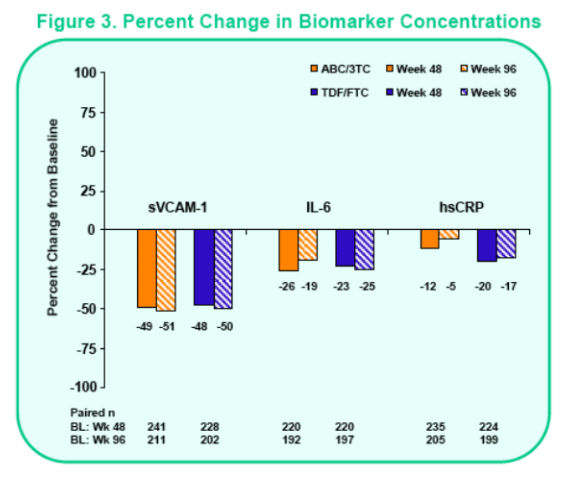
However, in contrast to most studies demonstrating a reduction in inflammatory marker levels with initiation of HIV therapy, data from a substudy of ACTG study A5095 found that hsCRP levels increased over 96 weeks among a subset of 100 patients randomized to receive either ZDV/3TC/EFV or ZDV/3TC/EFV/ABC (12). A subgroup analysis found that women experienced a greater and statistically significant increase in hsCRP during the course of the study while men had a statistically not significant rise in this biomarker. Exposure to ABC was not associated with hsCRP level. There was no significant correlations between the week 0-96 change in hs-CRP and week 0-96 change in body mass index, CD4 count or fasting metabolic measures [total, LDL and HDL-cholesterol, triglycerides, lactate, insulin resistance (HOMA-IR), glucose]
(Spearman's correlation coefficients all within +/- 0.1, with all p-values > 0.3). The investigators do not speculate on why hsCRP may have increased during this treatment-naïve study and hopefully further analyses including other biomarkers and potential explanations for these perplexing results will be forthcoming.
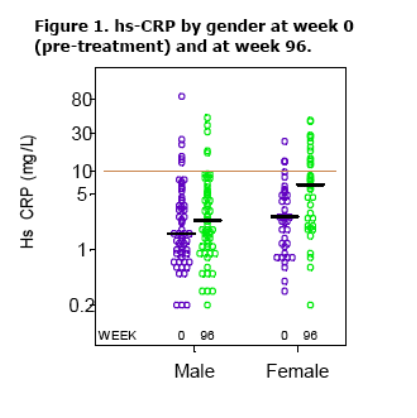
One of the most distressing studies regarding accelerated aging during HIV came from Colorado (13). Ten men with HIV infection, age 28 to 44 years and HIV treatment naïve underwent assessment of vascular endothelial function using forearm blood flow responses to infusions of acetylcholine (an endothelium dependent vasodilator) and sodium nitroprusside (an endothelium independent vasodilator). These results were compared to 10 HIV-uninfected men age 22 to 44 years, as well as 10 older HIV-uninfected men age 59 to 68. Vascular responses to acetylcholine in the HIV-positive men were significantly blunted and were comparable to those of the older HIV-negative men, suggesting premature vascular aging of the HIV-infected subjects.
There were no differences in vascular responses to the nitroprusside across the three groups, indicating the problem in the HIV-infected men is likely related to endothelial dysfunction. Remarkable results.
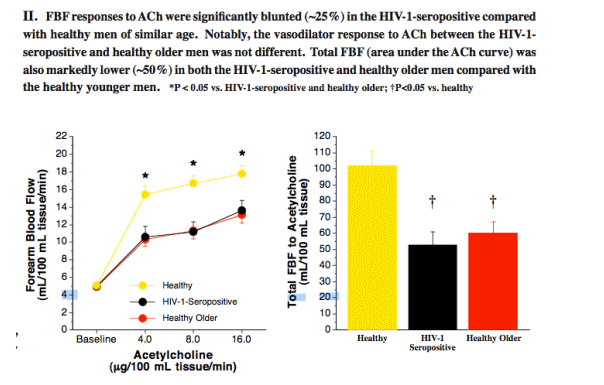
What This Means:
At this conference, inflammation as a cause of disease among HIV-positive people had a coming out party and the number of studies including measures of inflammation and coagulation was a telling signal that broad incorporation of these factors in future HIV research is in the offing.
Several years ago when confronted with severe fat loss, peripheral neuropathy and lactic acidosis among patients treated with thymidine analogues, we embraced a theory of mitochondrial dysfunction to explain these toxicities. Now, we are beginning to appreciate the ways in which chronic inflammation and endothelial dysfunction can cause disease among patients with HIV infection. Inflammation is not a cause, in and of itself, of disease, but is a result of other forces, be they virus-, co-infection- and/or therapy-related. As with body shape changes and cardiovascular health, we will benefit tremendously from work conducted outside of the HIV arena to develop a better understanding of the pathogenesis of accelerated aging during HIV infection and strategies to prevent or limit these effects. We are just getting a handle on the role of inflammation in disease among HIV-infected patients and with the tools available we are now able to detect the problem - a necessary first step in seeking a solution.
Postscript
As a complete aside, a secondary byproduct of the D:A:D presentation mentioned above was the very clear description (at last!) of the D:A:D study cohort - an important but often controversial observational study. My eyes could not help but bask in the glory of the revelatory slides describing the characteristics of this formidable cohort that brought abacavir to its knees and has lopinavir/ritonavir in its sights. We learned that 45% of the participants are not white or black African, a quarter have active viral hepatitis, over half do not have systolic blood pressure measured and that 68% have been exposed to HAART. Solid gold for anyone trying to decipher the meaning of the results that emanate from this powerful study. Clip and save.
References
1. Smith C. Abstract #145: Association between modifiable and non-modifiable risk factors and specific causes of death in the HAART era: The Data Collection of Adverse Eventes of Anti-HIV Drugs study (D:A:D). Paper presented at: 16th Conference on Retroviruses and Opportunistic Infections; February 2009; Montreal, CA
2. Morcroft A, Reiss P, Gasoprpwslo K, et al. Abstract # 707: Serious fatal and non-fatal AIDS-defining illnesses in Europe. Paper presented at: 16th Conference on Retroviruses and Opportunistic Infections; February 2009; Montreal, CA
3. Hurley L, Leyden W, Xu L, et al. Abstract # 710: Updated surveillance of cardiovascular event rates among HIV-infected Californians, 1996 to 2008. Paper presented at: 16th Conference on Retroviruses and Opportunistic Infections; February 2009; Montreal, CA
4. Modrich L, Scherzer R, Zolopa A, et al. Abstract # 706: Factors associated with mortalit in the study of fat redistribution and metabolic change in HIV infection. Paper presented at: 16th Conference on Retroviruses and Opportunistic Infections; February 2009; Montreal, CA
5. Kitahata M, Gange S, Moore R. Abstract # 71: Initiating rather than deferring HAART at a CD4 count >500 cells/mm3 is associated with improved survival. Paper presented at: 16th Conference on Retroviruses and Opportunistic Infections; February 2009; Montreal, CA
6. Kuller LH, Tracy R, Belloso W, De Wit S, Drummond F, Lane HC, et al for the INSIGHT SMART Study Group. Inflammatory and coagulation biomarkers and mortality in infection. PLoS Med 2008; 5(10):e203. doi:10.1371/journal.pmed.005.
7. Neuhaus J, et al. Markers of Inflammation, Coagulation, and Renal Function in HIV-infected Adults in the Strategies for Management of ART Study and in 2 Large Population-based Studies, Coronary Artery Risk Development in Young Adults and Multi-Ethnic Study of Atherosclerosis. Paper presented at: 16th Conference on Retroviruses and Opportunistic Infections; February 2009; Montreal, CA.
8. Rodger A, et al. Abstract 733. Does Activation of Inflammatory and Coagulation Pathways Independently Predict the Development of Opportunistic Disease in Patients with HIV Infection? Paper presented at: 16th Conference on Retroviruses and Opportunistic Infections; February 2009; Montreal, CA.
9. Heaton R, Franklin D, Clifford D, et al. Abstract #154: HIV-associated neurocognitive impairment remains prevalent in the era of combination ART: The CHARTER Study. Paper presented at: 16th Conference on Retroviruses and Opportunistic Infections; February 2009; Montreal, CA.
10. McComsey G, et al. Abstract #732: Similar Reductions in Markers of Inflammation and Endothelial Activation after Initiation of Abacavir/Lamivudine or Tenofovir/Emtricitabine: The HEAT Study. Paper presented at: 16th Conference on Retroviruses and Opportunistic Infections; February 2009; Montreal, CA.
11. Murphy R, et al. Abstract #722Endothelial Function, Lipoproteins,and Cardiovascular Inflammatory Markers in Treated HIV-infected Patients with Hyperlipidemia Who Were Switched to an Atazanavir-containing Regimen or Continued on Other Protease Inhibitor-based Therapy: Switch to Atazanavir and Brachial Artery Reactivity Study. Paper presented at: 16th Conference on Retroviruses and Opportunistic Infections; February 2009; Montreal, CA.
12. Shikuma C, et al. Abstract #736. 96-Week Effects of Suppressive Efavirenz-containing ART, Abacavir, and Sex on High-sensitivity C-reactive Protein: ACTG A5095. Paper presented at: 16th Conference on Retroviruses and Opportunistic Infections; February 2009; Montreal, CA.
13. Van Guilder G, Stauffer B, Mestek M, et al. Abstract #731: HIV-1 infection is associated with accelerated vascular aging. Paper presented at: 16th Conference on Retroviruses and Opportunistic Infections; February 2009; Montreal, CA.
|
| |
|
 |
 |
|
|